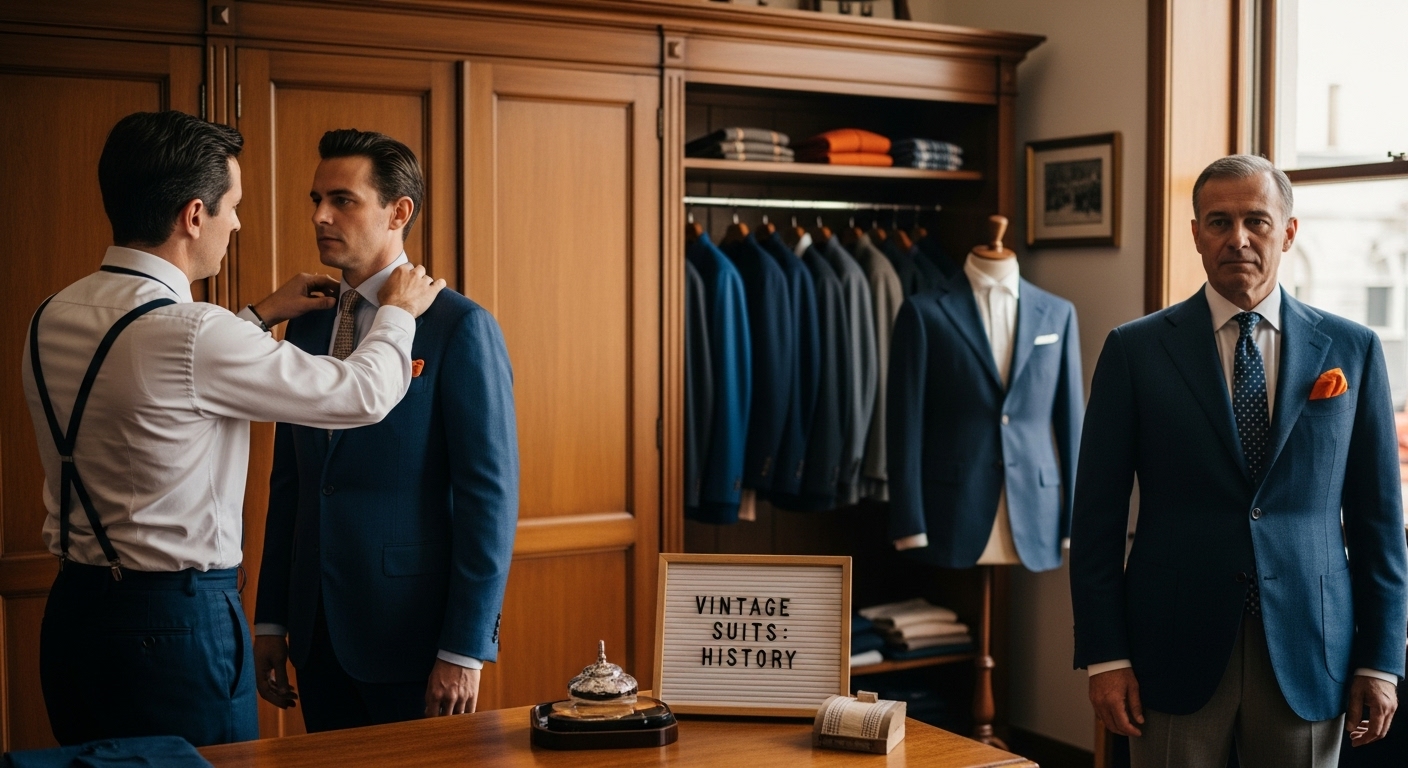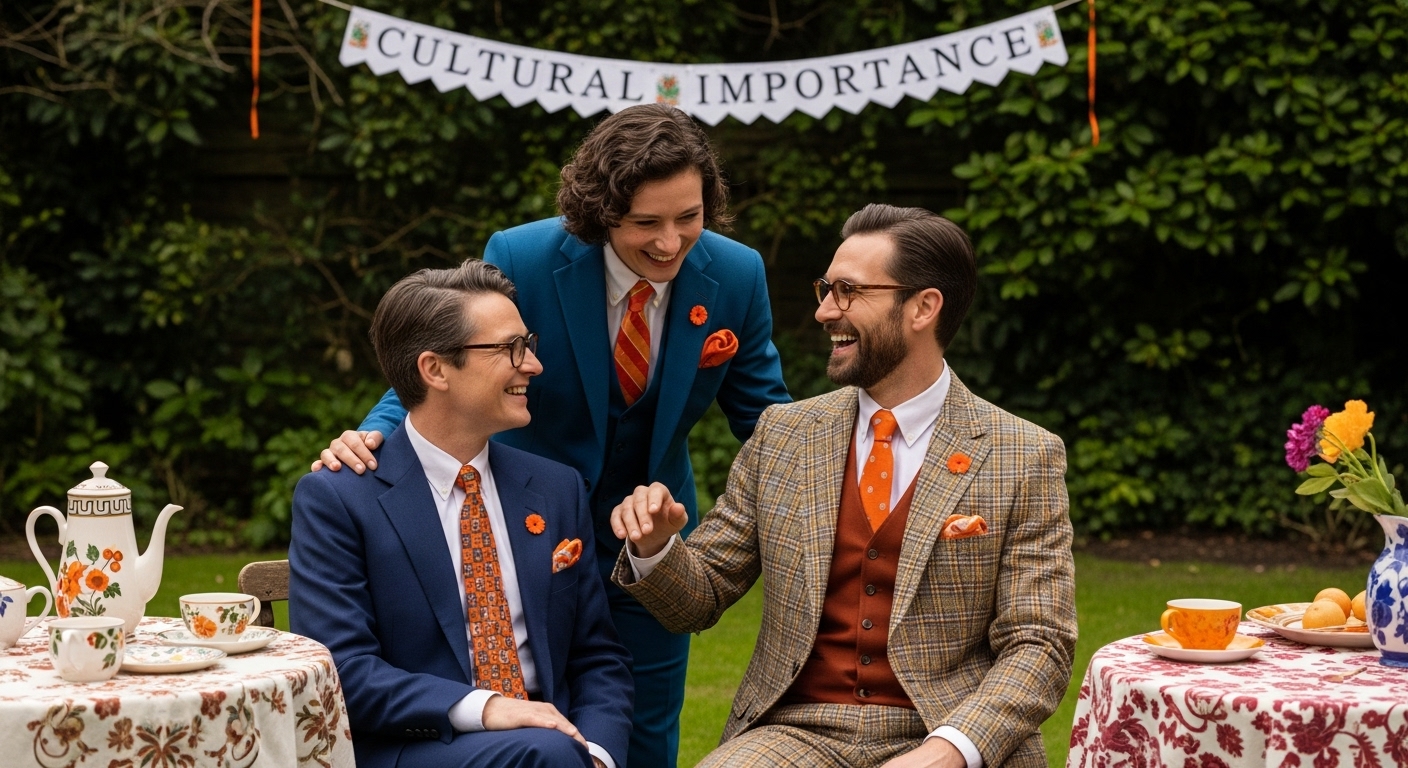Understanding Vintage Suits: History and Significance
- Emma

- Sep 26
- 8 min read

Vintage suits are much more than stylish relics hanging in the back of old wardrobes. Spotting a 1960s blazer with immaculate hand-stitching or running your hands over silk linings feels like discovering a secret history. Yet the real shock comes when you realise that a well-preserved vintage suit can be over 80 years old and still outshine most modern tailoring. There is a world where craftsmanship, social status, and sustainable fashion all collide in a single jacket.
Table of Contents
Quick Summary
Takeaway | Explanation |
Vintage suits are historical artifacts | They reflect the aesthetic and social dynamics of their eras, embodying craftsmanship and design significance. |
Authenticity is crucial when collecting | Genuine vintage suits feature specific construction techniques, original fabrics, and historical context. |
Craftsmanship details define quality | Vintage suits often have hand-stitched elements and bespoke tailoring that distinguish them from modern clothing. |
Sustainable fashion value | Wearing vintage suits promotes environmental sustainability by reducing waste and supporting circular fashion models. |
Preservation techniques matter | Proper storage and restoration methods are essential for maintaining the integrity and value of vintage suits. |
Defining Vintage Suits: Characteristics and Styles
Vintage suits represent more than just clothing; they are historical artefacts that encapsulate the aesthetic sensibilities and social dynamics of their respective eras. Exploring the nuanced world of vintage suits reveals a rich tapestry of design, craftsmanship, and cultural significance.
Understanding the Vintage Suit Criteria
A vintage suit is not merely an old garment but a meticulously crafted piece that embodies specific characteristics defining its authenticity and historical value. According to The Vintage Fashion Guild, a suit is typically considered “vintage” if it was manufactured between 20 and 100 years ago, with precise eras ranging from the 1920s through the 1980s.
Key hallmarks of authentic vintage suits include:
Distinctive Construction Techniques: Hand-stitched details, unique buttonhole placements, and intricate internal structures
Original Fabric Quality: Natural fibres like wool, silk, and cotton with superior weaving techniques
Period-Specific Tailoring: Variations in lapel width, jacket length, and trouser cut reflecting the fashion norms of specific decades
Stylistic Evolution of Vintage Suits
Each decade brought distinctive suit styles that reflected broader social and cultural transformations.
The 1930s introduced wider shoulders and more relaxed silhouettes, while the 1950s embraced a more structured, narrow-waisted aesthetic. Post-war suits often featured bolder patterns and experimental colour palettes, signalling a departure from wartime austerity.
The craftsmanship behind vintage suits demonstrates extraordinary attention to detail. Tailors of previous generations invested significant time in creating garments that were not just clothing but statements of personal identity and social standing. Precise measurements, hand-sewn linings, and carefully selected fabrics were standard practices that distinguished high-quality vintage suits from mass-produced contemporary alternatives.
Understanding vintage suits requires appreciation for their historical context, recognising them as more than mere fashion items but as tangible representations of social evolution and sartorial artistry.
The following table summarises the hallmark features that set authentic vintage suits apart from modern garments, highlighting key criteria collectors use to determine genuineness and quality.
Characteristic | Description |
Distinctive Construction | Hand-stitched details, unique buttonhole placements, intricate internal structures |
Original Fabric Quality | Natural fibres such as wool, silk, and cotton, often with superior weaving techniques |
Period-Specific Tailoring | Lapel widths, jacket lengths, and trouser cuts reflecting fashions of specific decades |
Label Verification | Manufacturer tags and internal markings unique to period and maker |
Fabric Composition Evaluation | Assessment of authentic, era-appropriate material |
Condition & Preservation | Quality of storage, minimal wear, and signs of professional restoration or care |
The Cultural Importance of Vintage Suits
Understanding why vintage fashion matters reveals how clothing transcends mere aesthetic choices and becomes a powerful narrative of social transformation. Vintage suits are not simply garments but intricate social documents that communicate complex stories about identity, status, and cultural evolution.
Social Identity and Professional Symbolism
In British society, suits have historically represented more than professional attire. They embodied social hierarchies, professional aspirations, and personal achievements. According to The British Council, suits were potent symbols of economic mobility and cultural sophistication.
Key social dimensions of vintage suits include:
Class Representation: Different suit styles signalled economic background and professional standing
Gender Dynamics: Evolving suit designs reflected changing workplace gender expectations
Cultural Expression: Suit variations demonstrated personal and professional identity
Psychological and Emotional Significance
Vintage suits carry profound psychological resonance. They represent personal and collective memories, connecting wearers to specific historical moments. The craftsmanship embedded in these garments speaks to a time of meticulous tailoring, where clothing was an investment rather than a disposable commodity.
Moreover, vintage suits serve as tangible links to familial and cultural heritage. A well-preserved suit can connect generations, telling stories of fathers, grandfathers, and their professional journeys. They become repositories of personal and collective memory, preserving narratives that extend beyond fabric and stitching.

By wearing vintage suits, individuals engage in a form of historical dialogue, celebrating craftsmanship, challenging contemporary fast-fashion culture, and expressing a nuanced understanding of style that transcends temporal boundaries.
Materials and Craftsmanship in Vintage Suits
Our guide to vintage menswear basics illuminates the extraordinary world of textile selection and artisanal techniques that define vintage suit production. These garments represent far more than clothing, embodying a sophisticated intersection of material science, artistic skill, and cultural expression.
Premium Natural Fabrics
Vintage suits distinguished themselves through meticulous fabric selection. Tailors predominantly used natural, high-quality materials that offered superior durability and aesthetic refinement. According to The Textile Research Journal, wool remained the quintessential vintage suit fabric, with specific variants like worsted wool, tweed, and flannel representing pinnacle craftsmanship.
Key fabric characteristics included:
Wool Varieties: Different regional wool types offering unique textures and performance
Weaving Techniques: Complex patterns like herringbone, twill, and plain weaves
Fabric Weight: Seasonal variations allowing breathability and thermal regulation
Artisanal Construction Techniques
Craftsmanship in vintage suits transcended mere clothing production, representing a holistic approach to garment creation. Master tailors employed intricate techniques that modern mass production has largely abandoned. Hand-stitching, precise pattern matching, and individually customised internal structures were standard practices.
The most remarkable aspect of vintage suit construction was its bespoke nature. Each garment underwent multiple fittings, with tailors meticulously adjusting every seam, lapel, and shoulder line to create a perfect silhouette. This personalised approach meant suits were not just worn but intimately designed for individual body shapes and personal styles.
Understanding vintage suit materials and craftsmanship reveals a profound respect for textile heritage, where clothing represented an art form balancing aesthetic beauty, functional design, and individual expression.
The Role of Vintage Suits in Sustainable Fashion
Vintage clothing represents the ultimate sustainable fashion choice by transforming textile consumption from a linear to a circular economic model. Vintage suits embody environmental consciousness, challenging contemporary fast-fashion paradigms through purposeful material reuse and preservation.
Environmental Impact Reduction
By choosing vintage suits, fashion enthusiasts directly mitigate textile waste and manufacturing carbon emissions. According to The British Fashion Council, secondhand clothing markets significantly reduce environmental strain compared to new garment production.
Key sustainability benefits include:
Carbon Footprint Reduction: Eliminating additional manufacturing processes
Resource Conservation: Preventing new raw material extraction
Waste Management: Extending textile lifecycle beyond initial production
Circular Fashion Economics
Vintage suits represent a profound statement in circular fashion economics. Rather than discarding garments after minimal use, these pieces are meticulously preserved, restored, and reimagined. The inherent durability of vintage suit construction means these garments can traverse multiple ownership cycles without significant structural degradation.
Moreover, vintage suits challenge prevailing consumption models by emphasising quality over quantity. Each preserved suit represents a deliberate choice against disposable fashion, celebrating craftsmanship and material longevity. By investing in vintage suits, individuals participate in a more sustainable fashion ecosystem that prioritises repair, reuse, and thoughtful consumption.
Understanding vintage suits through a sustainability lens reveals them not merely as clothing items, but as powerful statements of environmental stewardship and responsible fashion consumption.
This table outlines the environmental impact reduction and circular economic benefits of vintage suits compared to new clothing, helping readers clearly compare sustainability aspects.
Sustainability Factor | Vintage Suits | Modern Fast Fashion |
Carbon Footprint | No new manufacturing emissions | High emissions from production and shipping |
Resource Conservation | Preserves resources by reusing existing garments | Requires continual raw material extraction |
Waste Management | Extends textile life, reduces landfill waste | Often discarded quickly, contributes to landfill |
Consumption Model | Emphasises repair, reuse, and longevity | Prioritises frequent replacement and disposability |
Economic Lifecycle | Circular: multiple owners and long-term use | Linear: short ownership and disposal |
Collecting Vintage Suits: Trends and Tips
Vintage men’s clothing trends offer fascinating insights into the nuanced world of suit collecting. This pursuit transcends mere fashion acquisition, representing an intricate blend of historical appreciation, investment strategy, and personal style curation.
Identifying Authentic Vintage Suits
Authenticity remains paramount when collecting vintage suits. Discerning collectors develop keen observational skills to distinguish genuine vintage pieces from modern reproductions. According to The Victoria and Albert Museum, key authentication markers include original manufacturing labels, specific stitching techniques, and period-appropriate fabric construction.
Essential authentication criteria involve:
Label Verification: Examining manufacturer tags and internal markings
Construction Technique Analysis: Assessing hand-stitching and seam configurations
Fabric Composition Evaluation: Determining original material authenticity
Strategic Collecting Approaches
Successful vintage suit collection demands a strategic approach that balances aesthetic appreciation with preservation considerations. Collectors should prioritise suits from specific historical periods, focusing on exceptional craftsmanship and minimal wear. Condition becomes a critical investment factor, with pristine pieces commanding significantly higher value.
Preservation techniques are equally crucial. Climate-controlled storage, acid-free tissue paper, padded hangers, and minimal direct sunlight exposure help maintain suit integrity. Collectors must also consider professional restoration services for minor repairs, ensuring the garment’s historical and aesthetic value remains intact.
Vintage suit collecting represents more than accumulating clothing. It is an intellectual pursuit of preserving sartorial heritage, connecting contemporary fashion enthusiasts with the extraordinary craftsmanship of previous generations.
Discover the Authentic World of Vintage Suits at My Vintage
Have you ever struggled to find a truly original vintage suit that captures genuine history, expert craftsmanship, and that unmistakable sense of individual style? If the article on the history and significance of vintage suits resonated with you, it is likely because mass-produced fashion cannot offer the authenticity, tailoring, and prestige that a real vintage piece provides. Many people find themselves wishing for a trusted source where every item has a story, and every purchase is a celebration of sustainable, high-quality fashion. At My Vintage, we understand your desire for garments that combine historical artistry with eco-conscious choices. Our diverse collection features authentic vintage suits and apparel handpicked for their period-specific details, fine fabrics, and exceptional condition.

Ready to experience the difference? Step away from disposable trends and embrace clothing with real heritage and character. Explore our meticulously curated selection at My Vintage, where you will find pieces that honour the very principles described in our guide to vintage menswear basics and embody the value of vintage clothing as sustainable fashion. Connect with history and invest in your unique style today.
Frequently Asked Questions
What defines a vintage suit?
A vintage suit is typically defined as a garment manufactured between 20 and 100 years ago, featuring distinctive construction techniques, original fabric quality, and period-specific tailoring that reflects the fashion norms of its era.
Why are vintage suits significant in terms of cultural identity?
Vintage suits represent more than just clothing; they embody social hierarchies, professional aspirations, and personal achievements, making them potent symbols of economic mobility and cultural sophistication.
What materials are commonly used in vintage suits?
Vintage suits are often crafted from high-quality natural fabrics, primarily wool, along with other materials like silk and cotton. These fabrics offer superior durability and often feature complex weaving techniques, enhancing both texture and visual appeal.
How can I determine the authenticity of a vintage suit?
To verify the authenticity of a vintage suit, examine original manufacturing labels, assess hand-stitching and seam configurations, and evaluate the fabric composition. Authentic vintage suits should show signs of expert craftsmanship that distinguish them from modern reproductions.
Recommended








Comments